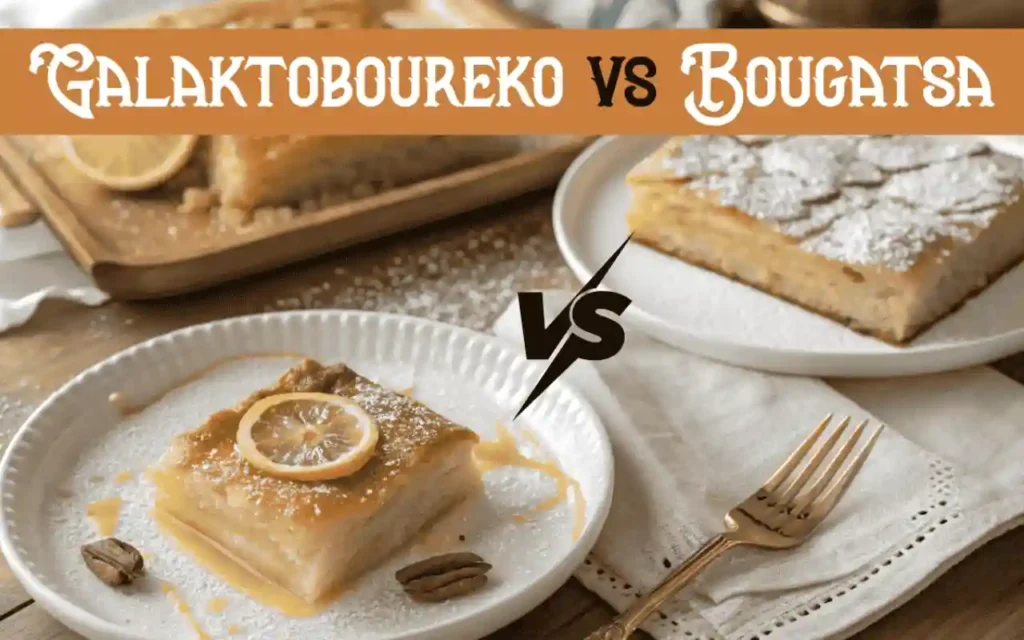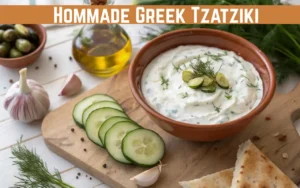Two Greek desserts. Both wrapped in crispy filo. Both oozing with creamy filling. Yet ask a local, and they’ll passionately defend their favorite. Welcome to the delicious rivalry of Galaktoboureko vs Bougatsa—a custard-filled culinary showdown that’s as much about regional pride as it is about dessert.
In this article, we’ll break down what makes each pastry special, how they differ in flavor and texture, and when to serve them.
Table of Contents
What Is Galaktoboureko?

Galaktoboureko is a baked Greek dessert made with layers of butter-brushed filo dough, filled with a rich semolina custard, and soaked in lemon-scented syrup after baking. It’s typically served in square slices or diamond cuts.
- Origin: Believed to have roots in Northern Greece and Byzantine-era kitchens.
- Flavor profile: Creamy, dense, citrusy with a sweet syrup glaze.
- When served: Usually warm, especially at festive gatherings or Sunday dinners.
What Is Bougatsa?

Bougatsa is a lighter, often breakfast-style pastry that comes with various fillings—custard being the most iconic for dessert lovers. Unlike galaktoboureko, bougatsa is not syrup-soaked, and is often dusted with powdered sugar and cinnamon.
- Origin: Thessaloniki and Northern Greece are bougatsa’s spiritual homes.
- Flavor profile: Flaky, airy, buttery, and gently sweet.
- When served: Hot or warm, often as a street snack or café breakfast.
Key Differences in Ingredients and Flavor
| Element | Galaktoboureko | Bougatsa |
|---|---|---|
| Filling | Semolina custard | Cream custard or cheese |
| Topping | Syrup-soaked | Sugar & cinnamon sprinkle |
| Serving Temp | Warm or room temp | Always warm & fresh |
| Texture | Dense and moist | Light, flaky, crispy |
| Occasion | Dessert-focused, formal | Breakfast, snack, casual sweet |
Custard Base: Semolina vs Cream
- Galaktoboureko uses a custard made with semolina, milk, eggs, and lemon zest. It sets more firmly.
- Bougatsa custard is looser and silkier—more of a béchamel-style cream, sometimes thickened without eggs.
Both use filo, but bougatsa is usually wrapped in fewer, thicker layers.
Explore more creamy treats in Custards and Filo Sweets Or return to our Ultimate Guide to Greek Desserts to discover every traditional variety.
Preparation and Texture
- Galaktoboureko: Baked in a tray, sliced post-bake, and drenched in syrup.
- Bougatsa: Often assembled as individual hand pies or squares and served hot out of the oven.
- Crunch level: Bougatsa wins for immediate crispness; galaktoboureko wins for syrup-soaked richness.
When to Serve Each Dessert
- Serve galaktoboureko when you want a formal dessert—after a Greek dinner, for holidays, or paired with coffee.
- Serve bougatsa for brunch, a sweet morning bite, or even as a late-night comfort food.
Frequently Asked Questions
hich is sweeter—galaktoboureko or bougatsa?
Galaktoboureko tends to be sweeter due to its syrup. Bougatsa has a subtler sweetness.
Can I make these without filo dough?
No real substitute exists—filo is essential to both desserts’ texture and identity.
Is one easier for beginners?
Bougatsa is generally simpler and quicker to assemble, especially in single-serve portions.





3 thoughts on “What’s is the Difference Betwen Galaktoboureko and Bougatsa”
Comments are closed.